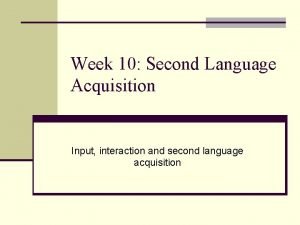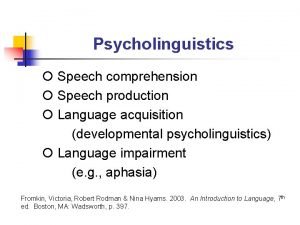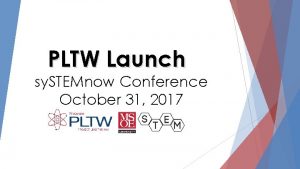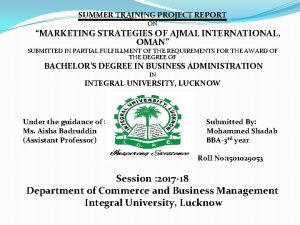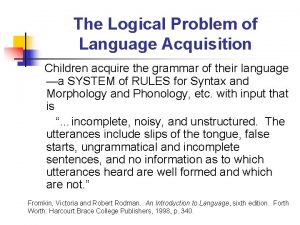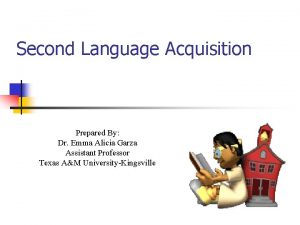Language Acquisition and Language Levels Teacher Training Summer















- Slides: 15

Language Acquisition and Language Levels Teacher Training Summer 2014 8: 00 am- 9: 30 pm

Second Language Acquisition • Second language acquisition or SLA is the process of acquiring/learning other languages in addition to the native language. • Process of how they become fluent in English • Success/speed of acquiring a second language is based on home experiences, parents’ backgrounds, and English abilities

Acquiring vs. Learning • Acquisition is the subconscious process of attaining the subtleties of language and culture. • Learning refers to the process by which students become aware of the “rules” of the target language. • BICS – Basic Interpersonal Communication Skills • CALP – Cognitive Academic Language Proficiency

How do ELLs Acquire Language? - Use existing knowledge from their first language. - It’s important for us as teacher to make connections whenever possible - Construct a transitional system from L 1 to L 2. - Communication strategies help to overcome breakdowns of communication.

Common Myths • Myth #1: Students can learn English quickly by being exposed to and surrounded by native language speakers. • Myth #2: The ability to converse comfortably in English signals proficiency and means the child should be achieving academically. • Myth #3: Students should learn English before attempting to study an academic subject in that language. • Myth #4: ESL students should stop speaking their native language and concentrate on speaking English.

Newcomers • How They Feel • Overwhelmed and Exhausted • Culture Shock • How They Might Act • What Newcomers Can Do • What They Will Need • Academically • Emotionally • Culturally • Family Dynamics • Build Relationship with Their Caregivers • Classroom Aesthetics • Positive • Their Name • School Tour

Newcomers • Classroom Procedures • Label Items • Make Illustrated Routine Charts • Merge Content with Language Activities • Buddy • Help them learn the classroom routine. • Take them to ESL class and back again. • Sit with them in the lunchroom. • Use gestures and short phrases. • Teach them the ABCs, numbers, phrases • Include them in games on the playground. • Play vocabulary games with them. • Sit with them on the bus. • Learn a few words of the newcomer's language.

Newcomers • Instruction • Roman Alphabet • Colors, Numbers, Shapes, Body Parts, • Classroom Object Labels • Survival Vocabulary and Phrases • Modeling • Total Physical Response • Repetition! • Sentence Frames • Visuals • Organization – Folder or Portfolio • Dictionary – Personal and Published • Flashcards • Computer Programs • Read Aloud Everyday!

Newcomers • Visuals • Photographs • Powerpoint Slides • Videos • Realia • Drawings/Sketches • Miming/Gestures • Speech • Exaggerated Emotions/Voice Inflection • Clear, Slower pace • Concise • Simple sentences • Pauses • Limit Idioms • Reassuring, Calm

Newcomers • When They Speak • Don’t Overcorrect----Model • Check for Understanding • Allow Ample Processing Time • Give Advanced Notice • Choral Reading • When They Write • Model-Clear, Legible, Concise Sentences • Provide Sentence Frames • Don’t Overcorrect----Model • Allow them to correct their own work. • Focus on individual skills gradually.

All Other ESL Students • Descriptors/levels based on ELDA scores • All the newcomer strategies and be modified for these levels too. • Intermediate • Level 2, 3, or 4 in every domain • Emerging Fluency • 1 st or 2 nd year with Level 4 or 5 in nearly every domain • Long Term ELLs • 3+ years with Level 4 or 5 in every domain

English Language Development Tool (ELDT) • Springdale School District’s resource • Teaching strategies • What to expect of students are various language proficiency levels • Change the descriptors based on the levels of proficiency in all language domains (listening, speaking, reading, and writing).

Small Group Activity 1 • Think Pair Share about Each Level • With your partner, discuss the following points then be ready to share with the whole group: • • Describe student Describe your attitude toward the student Describe your classroom related to him/her Describe the other students’ reactions/partnership with the ELLs at each level

Small Group Activity 2 • Dialogue with group about Google Drive research and resources. • Focus your attention of elements related to your level and language domain • Be ready to share (Below is what’s expected): • Language acquisition ah-ha moments • Language domain explanation • Proficiency level explanation • What is expected of a student • What the student may be struggling with • How you might be able to help a student at that level

ELL Profile Case Studies • Newcomers – Level 1 or 2 in every domain • Intermediate – Level 2, 3, or 4 in every domain • Emerging Fluency – 1 st or 2 nd year with Level 4 or 5 in nearly every domain • Long Term ELLs – 3+ years with Level 4 or 5 in every domain • Hypothetical Student Presentations • Use chart paper and the ELDT resource • Sketch the student, and choose a content area. • What vocabulary support will be needed? • Determine some appropriate strategies. • How will you need to scaffold for this student? • What challenges will most likely arise?
 What is language acquisition
What is language acquisition Language learning with youtube
Language learning with youtube Psychomotor considerations language acquisition
Psychomotor considerations language acquisition Costa's level of question
Costa's level of question Requirements for erf for master teacher
Requirements for erf for master teacher Good afternoon teacher.
Good afternoon teacher. Input and interaction in second language acquisition
Input and interaction in second language acquisition Vvvwwwxxxx
Vvvwwwxxxx Systematicity and variability in first language acquisition
Systematicity and variability in first language acquisition Flowarm pltw software
Flowarm pltw software Summer training project report on marketing for bba
Summer training project report on marketing for bba Ongc internship form
Ongc internship form The logical problem of language acquisition
The logical problem of language acquisition Innateness theory
Innateness theory Language
Language Language acquisition device
Language acquisition device






